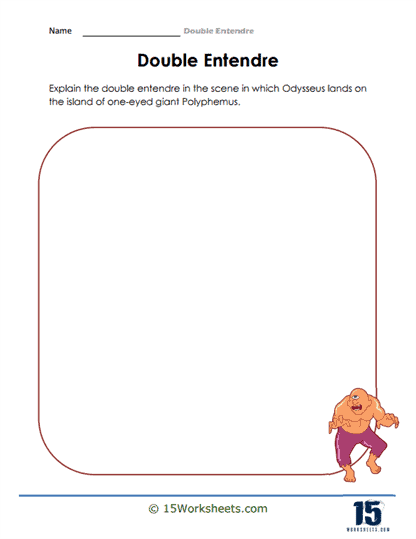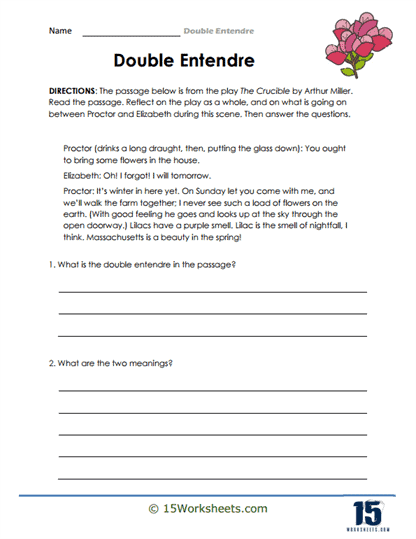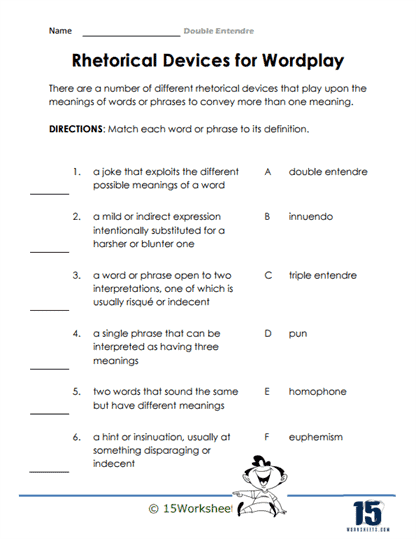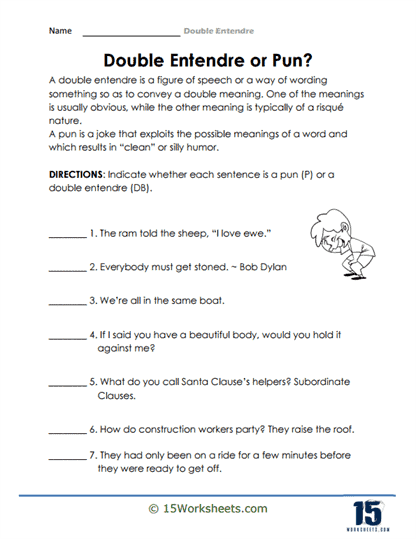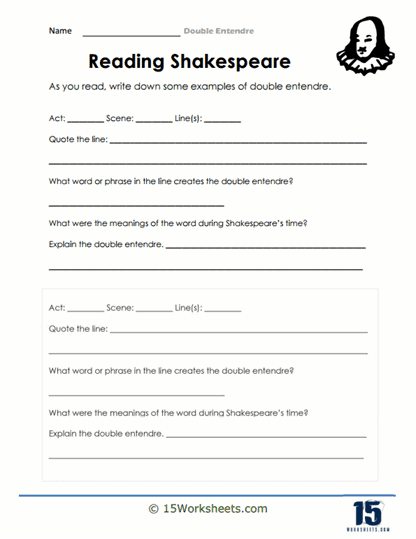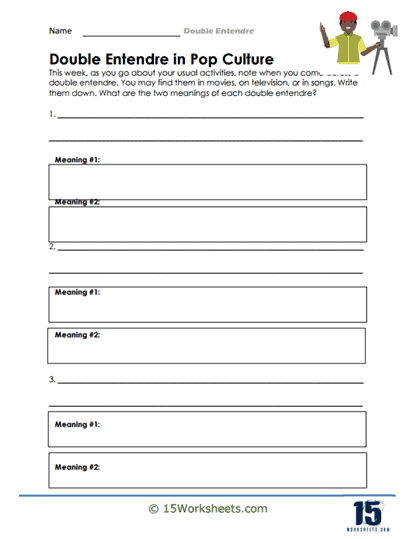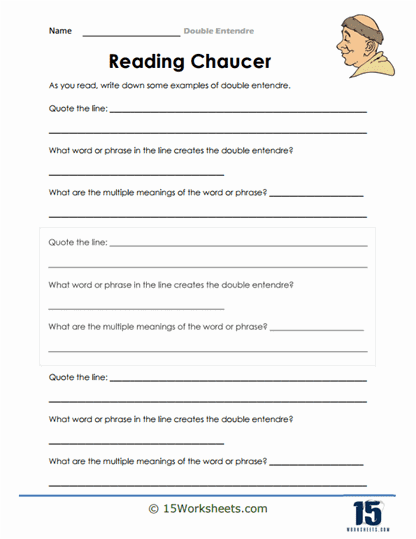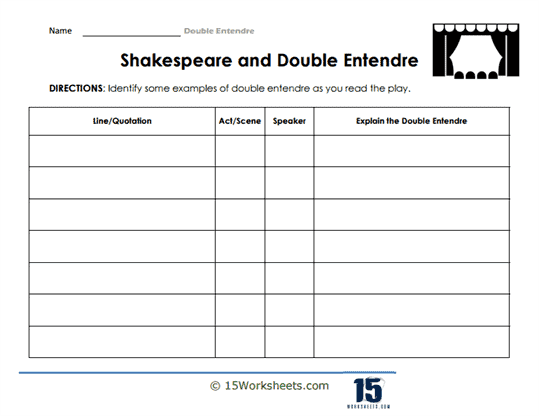Double Entendre Worksheets
All About These 15 Worksheets
The concept of double entendre, often referred to as a “double meaning,” is a linguistic device that adds depth and complexity to language. A well-executed double entendre can be both witty and thought-provoking, making it a fascinating aspect of language and communication. This collection of 15 worksheets is designed to introduce students to the world of double entendre, helping them understand its importance, recognize its usage, and harness its power in their own communication.
A double entendre is a figure of speech or a particular way of wording that is devised to have two meanings, of which one is typically obvious, while the other often has a humorous, ironic, or suggestive nature. The double entendre can add depth, humor, or sophistication to writing and dialogue, making it a powerful tool for writers.
These worksheets were created to help students identify and understand the use of this device in different pieces of literature or everyday language. These worksheets can enhance students’ analytical thinking and interpretation skills. Let’s break down what you might expect to see on these worksheets:
Definition and Examples – The worksheet will start by providing a clear definition of a double entendre, along with some suitable examples from literature, film, or everyday conversation. This will serve as an introduction to the concept.
Identification Exercises – This section involves various sentences or dialogues that employ double entendre. The students will be asked to identify the two meanings implied in each example. This will help reinforce their understanding of the concept.
Interpretation Questions – Here, students will be asked to explain why an author chose to use a double entendre in a particular context. This can help students understand how double entendre contributes to humor, suspense, or thematic depth.
Creative Writing Prompt – These worksheets ask students to craft their own sentences or a short dialogue using double entendre. This activity will encourage students to think creatively and to consider how word choice can affect the tone and meaning of a text.
Contextual Exercises – In this section, students will be provided with an excerpt from a novel, a poem, or a play in which a double entendre is used. They would then be asked to explain the double entendre in context, considering factors like the characters involved, the scene, and the overall plot of the work.
By working through these exercises, students will be better equipped to understand and appreciate the nuances of language and the craft of writing. This understanding can enhance their reading comprehension, as well as their ability to communicate effectively and creatively.
What is the Literary Device of Double Entendre?
The term “double entendre” originates from French, meaning “double understanding” or “double interpretation.” It is a literary device that employs dual meanings, often one surface-level meaning and another underlying meaning, which may carry a suggestive, ironic, or humorous connotation.
The defining feature of a double entendre is this dual interpretability. It is intended to be understood in two ways, with one interpretation typically more socially acceptable or straightforward, and the other more complex or risqué.
Authors utilize double entendre to introduce layers of meaning to their work, thereby enhancing the richness and depth of their narrative or dialogue. This device can provide humor, create dramatic irony, suggest sexual or risqué connotations, and veil criticism or satire. By employing double entendres, authors can engage readers in more dynamic, thought-provoking ways, challenging them to decode the layers of meaning.
Instances of Double Entendre in Literature
Example 1 – Shakespeare’s “Hamlet”
In Act 3, Scene 2, Hamlet is speaking to Ophelia when he says, “Lady, shall I lie in your lap?” Ophelia takes this literally and responds with confusion, while Hamlet clarifies by saying, “No, I mean my head upon your lap.” Here, the double entendre lies in the word “lie,” which can mean both “to recline” and “to be untruthful” or, more provocatively, can carry a sexual implication.
This exchange showcases Hamlet’s dark humor and his bitter, ambiguous relationship with Ophelia. Shakespeare employs this double entendre to hint at the sexual tension between the characters and to reinforce the theme of appearance versus reality that runs throughout the play.
Example 2 – Charles Dickens’s “Oliver Twist”
Dickens frequently uses double entendre to criticize societal norms and class systems subtly. For example, in describing the Beadle, Mr. Bumble, Dickens writes, “The board were sitting in solemn conclave when Mr. Bumble rushed into the room in great excitement, and addressing the gentleman in the high chair, said, ‘Mr. Limbkins, I beg your pardon, sir! Oliver Twist has asked for more!'” The phrase “asked for more” is a double entendre. On one level, it refers to Oliver’s request for more food; on another level, it highlights the audacity of a lower-class boy asking for more than what he’s given, defying the societal norms of the time.
Through this double entendre, Dickens critiques the harsh conditions of workhouses and the rigid societal hierarchy, encouraging readers to question these systems.
Example 3 – J.K. Rowling’s “Harry Potter” series
Rowling’s series is rife with double entendres, especially in character names. For example, “Remus Lupin” is a character who happens to be a werewolf. The name “Remus” is a reference to the mythological story of Remus and Romulus, who were raised by a she-wolf. “Lupin” derives from “lupus,” the Latin word for wolf. Here, the double entendre lies in the name itself, which, on the surface, is just a character’s name, but on a deeper level, foreshadows Lupin’s true nature as a werewolf.
This clever use of double entendre not only adds depth to Rowling’s character but also creates a sense of foreshadowing and suspense, engaging readers more fully in the story.
Importance Of Understanding Double Entendre For Students
Understanding and appreciating double entendre is crucial for several reasons:
- Enhanced Communication Skills: Mastery of language includes not only vocabulary and grammar but also the ability to convey ideas with nuance and subtlety. Double entendre is a powerful tool for effective communication, enabling students to express complex thoughts and emotions with creativity and precision.
- Literary Analysis: Double entendre is a common literary device used in poetry, prose, and drama. By studying this aspect of language, students can deepen their understanding of literature, analyze texts more effectively, and appreciate the artistry of authors and poets.
- Cultural Awareness: Double entendre is not limited to a single language or culture. It exists in various forms across different languages and societies. Exploring double entendre can foster cultural awareness and an appreciation of the diversity of language usage around the world.
- Critical Thinking: Recognizing and deciphering double entendre requires critical thinking skills. Students must analyze context, tone, and wordplay to discern the intended meaning, which sharpens their analytical abilities.
- Humor and Creativity: Double entendre often serves as a source of humor and creativity in language. By engaging with this topic, students can develop their creative thinking and sense of humor, which can be valuable in both personal and professional contexts.




